BM522 Project Management: TfL Music Event Plan & Stakeholder Analysis
VerifiedAdded on 2023/06/18
|17
|1934
|148
Report
AI Summary
This report presents a comprehensive project management plan for a Transport for London (TfL) music event, focusing on the staging of an operetta. It begins by comparing agile, waterfall, and Prince2 project management methodologies, advocating for agile due to its superior quality, flexibility, and risk reduction capabilities. The report includes a Gantt chart and a critical path diagram to schedule and visualize project activities, highlighting critical activities and determining the shortest possible project duration. A stakeholder analysis identifies and assesses the influence and interest of various internal and external stakeholders, such as the project manager, team members, government, audience, suppliers, and investors. The work breakdown structure (WBS) decomposes the project into manageable tasks, and a risk analysis identifies potential risks and mitigation strategies. Finally, the report discusses quality expectations, acceptance criteria, and measures to control the event, ensuring its successful execution. Desklib provides access to this and other solved assignments for students.

TRANSPORT FOR LONDON
Paraphrase This Document
Need a fresh take? Get an instant paraphrase of this document with our AI Paraphraser
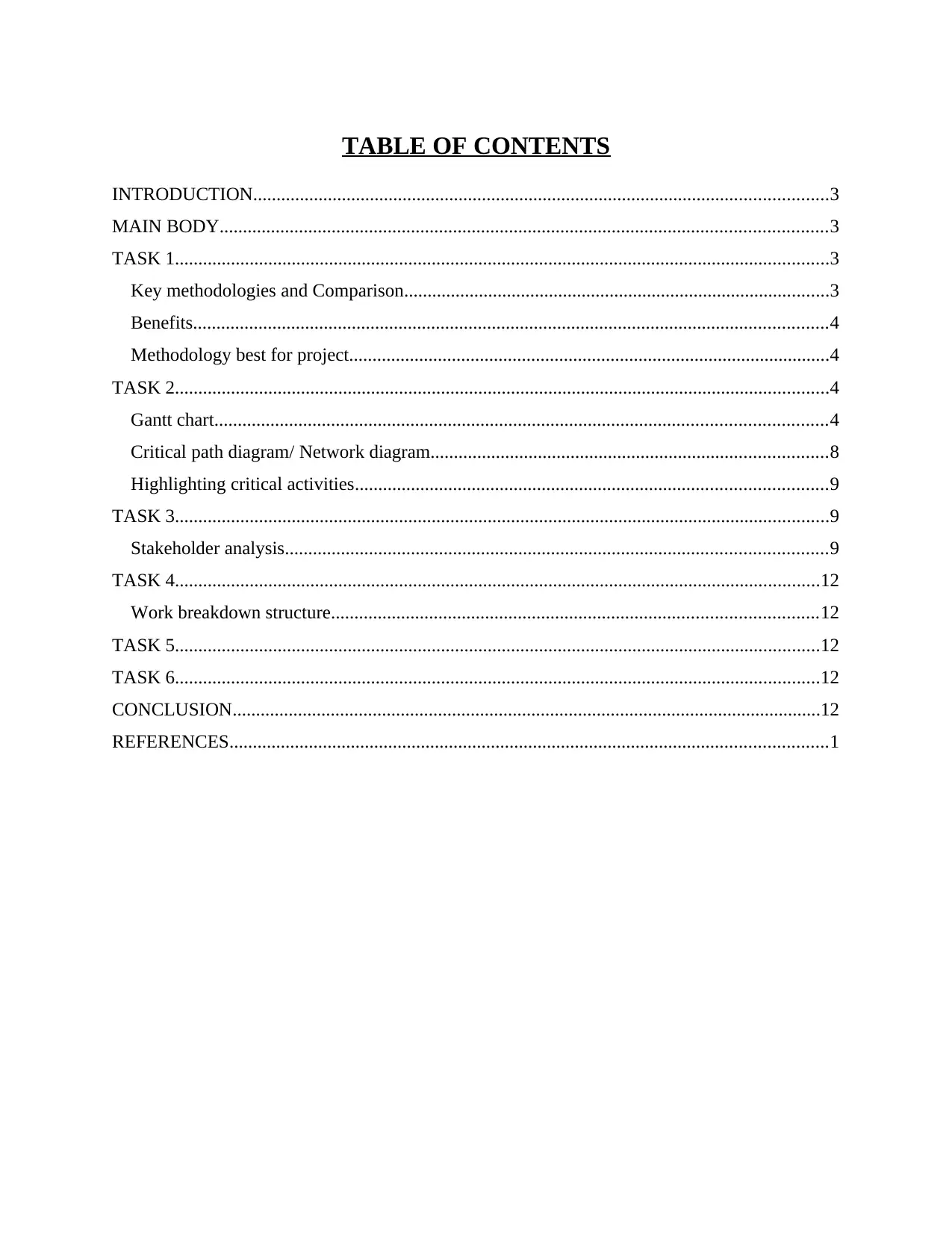
TABLE OF CONTENTS
INTRODUCTION...........................................................................................................................3
MAIN BODY..................................................................................................................................3
TASK 1............................................................................................................................................3
Key methodologies and Comparison...........................................................................................3
Benefits........................................................................................................................................4
Methodology best for project.......................................................................................................4
TASK 2............................................................................................................................................4
Gantt chart...................................................................................................................................4
Critical path diagram/ Network diagram.....................................................................................8
Highlighting critical activities.....................................................................................................9
TASK 3............................................................................................................................................9
Stakeholder analysis....................................................................................................................9
TASK 4..........................................................................................................................................12
Work breakdown structure........................................................................................................12
TASK 5..........................................................................................................................................12
TASK 6..........................................................................................................................................12
CONCLUSION..............................................................................................................................12
REFERENCES................................................................................................................................1
INTRODUCTION...........................................................................................................................3
MAIN BODY..................................................................................................................................3
TASK 1............................................................................................................................................3
Key methodologies and Comparison...........................................................................................3
Benefits........................................................................................................................................4
Methodology best for project.......................................................................................................4
TASK 2............................................................................................................................................4
Gantt chart...................................................................................................................................4
Critical path diagram/ Network diagram.....................................................................................8
Highlighting critical activities.....................................................................................................9
TASK 3............................................................................................................................................9
Stakeholder analysis....................................................................................................................9
TASK 4..........................................................................................................................................12
Work breakdown structure........................................................................................................12
TASK 5..........................................................................................................................................12
TASK 6..........................................................................................................................................12
CONCLUSION..............................................................................................................................12
REFERENCES................................................................................................................................1
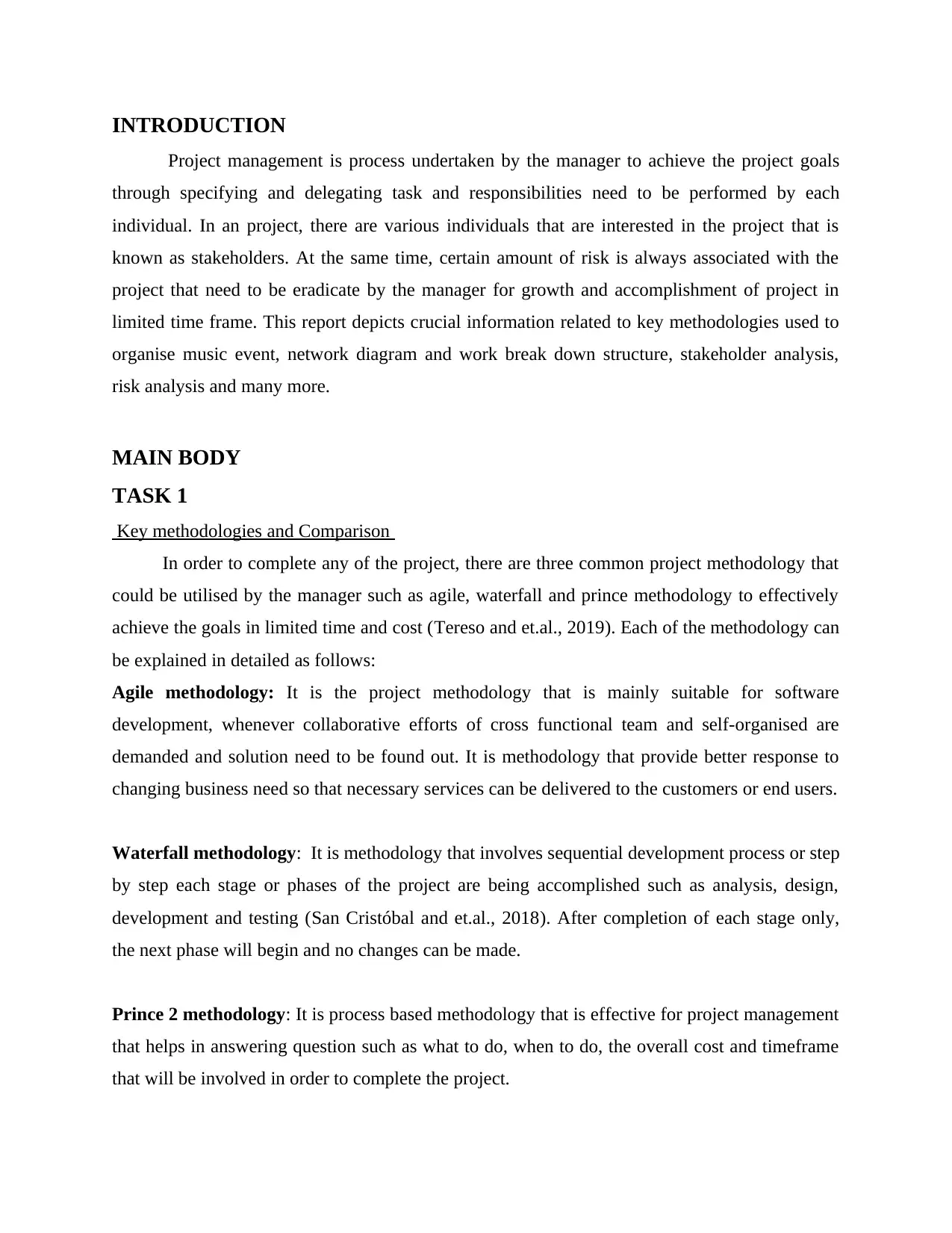
INTRODUCTION
Project management is process undertaken by the manager to achieve the project goals
through specifying and delegating task and responsibilities need to be performed by each
individual. In an project, there are various individuals that are interested in the project that is
known as stakeholders. At the same time, certain amount of risk is always associated with the
project that need to be eradicate by the manager for growth and accomplishment of project in
limited time frame. This report depicts crucial information related to key methodologies used to
organise music event, network diagram and work break down structure, stakeholder analysis,
risk analysis and many more.
MAIN BODY
TASK 1
Key methodologies and Comparison
In order to complete any of the project, there are three common project methodology that
could be utilised by the manager such as agile, waterfall and prince methodology to effectively
achieve the goals in limited time and cost (Tereso and et.al., 2019). Each of the methodology can
be explained in detailed as follows:
Agile methodology: It is the project methodology that is mainly suitable for software
development, whenever collaborative efforts of cross functional team and self-organised are
demanded and solution need to be found out. It is methodology that provide better response to
changing business need so that necessary services can be delivered to the customers or end users.
Waterfall methodology: It is methodology that involves sequential development process or step
by step each stage or phases of the project are being accomplished such as analysis, design,
development and testing (San Cristóbal and et.al., 2018). After completion of each stage only,
the next phase will begin and no changes can be made.
Prince 2 methodology: It is process based methodology that is effective for project management
that helps in answering question such as what to do, when to do, the overall cost and timeframe
that will be involved in order to complete the project.
Project management is process undertaken by the manager to achieve the project goals
through specifying and delegating task and responsibilities need to be performed by each
individual. In an project, there are various individuals that are interested in the project that is
known as stakeholders. At the same time, certain amount of risk is always associated with the
project that need to be eradicate by the manager for growth and accomplishment of project in
limited time frame. This report depicts crucial information related to key methodologies used to
organise music event, network diagram and work break down structure, stakeholder analysis,
risk analysis and many more.
MAIN BODY
TASK 1
Key methodologies and Comparison
In order to complete any of the project, there are three common project methodology that
could be utilised by the manager such as agile, waterfall and prince methodology to effectively
achieve the goals in limited time and cost (Tereso and et.al., 2019). Each of the methodology can
be explained in detailed as follows:
Agile methodology: It is the project methodology that is mainly suitable for software
development, whenever collaborative efforts of cross functional team and self-organised are
demanded and solution need to be found out. It is methodology that provide better response to
changing business need so that necessary services can be delivered to the customers or end users.
Waterfall methodology: It is methodology that involves sequential development process or step
by step each stage or phases of the project are being accomplished such as analysis, design,
development and testing (San Cristóbal and et.al., 2018). After completion of each stage only,
the next phase will begin and no changes can be made.
Prince 2 methodology: It is process based methodology that is effective for project management
that helps in answering question such as what to do, when to do, the overall cost and timeframe
that will be involved in order to complete the project.
⊘ This is a preview!⊘
Do you want full access?
Subscribe today to unlock all pages.

Trusted by 1+ million students worldwide
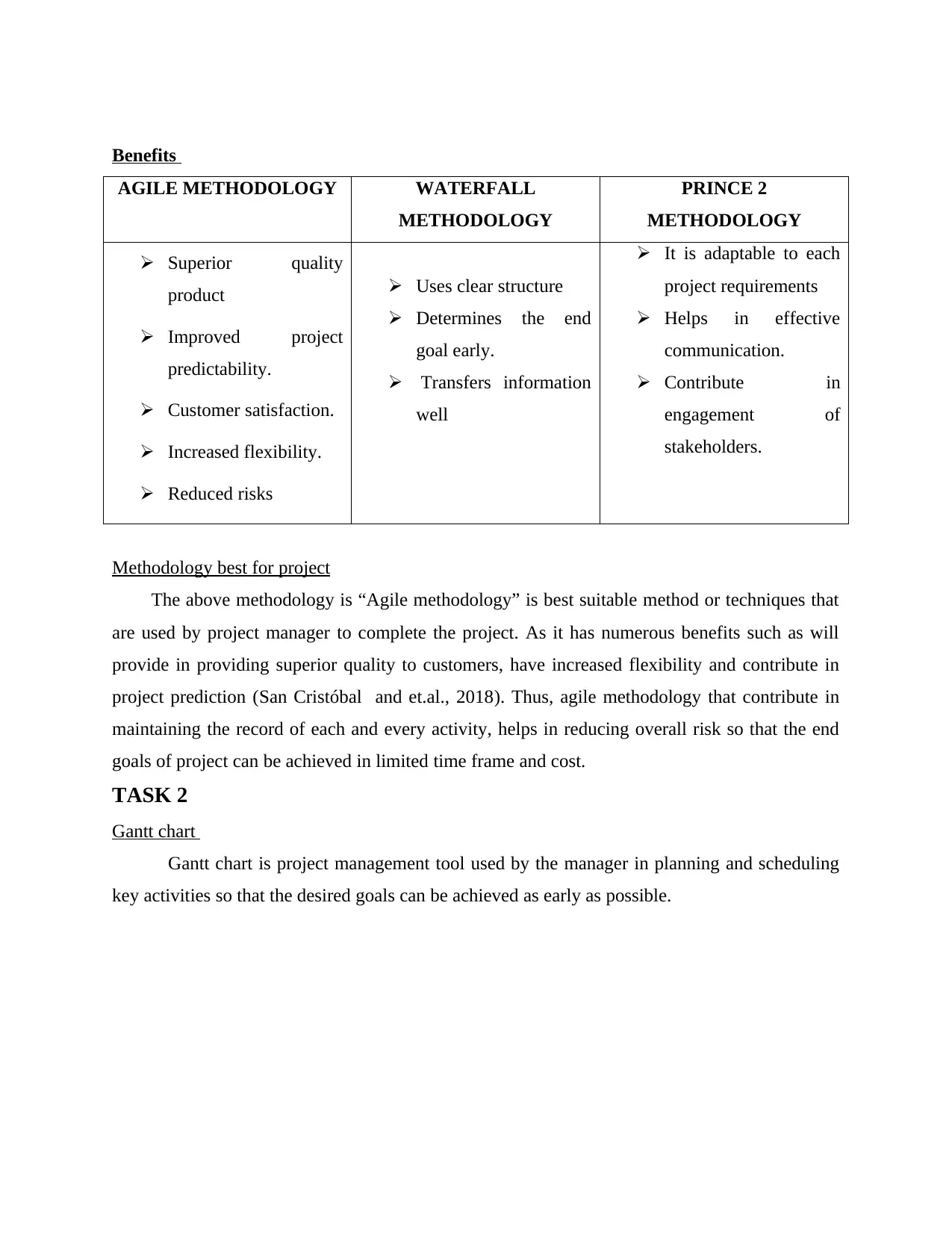
Benefits
AGILE METHODOLOGY WATERFALL
METHODOLOGY
PRINCE 2
METHODOLOGY
Superior quality
product
Improved project
predictability.
Customer satisfaction.
Increased flexibility.
Reduced risks
Uses clear structure
Determines the end
goal early.
Transfers information
well
It is adaptable to each
project requirements
Helps in effective
communication.
Contribute in
engagement of
stakeholders.
Methodology best for project
The above methodology is “Agile methodology” is best suitable method or techniques that
are used by project manager to complete the project. As it has numerous benefits such as will
provide in providing superior quality to customers, have increased flexibility and contribute in
project prediction (San Cristóbal and et.al., 2018). Thus, agile methodology that contribute in
maintaining the record of each and every activity, helps in reducing overall risk so that the end
goals of project can be achieved in limited time frame and cost.
TASK 2
Gantt chart
Gantt chart is project management tool used by the manager in planning and scheduling
key activities so that the desired goals can be achieved as early as possible.
AGILE METHODOLOGY WATERFALL
METHODOLOGY
PRINCE 2
METHODOLOGY
Superior quality
product
Improved project
predictability.
Customer satisfaction.
Increased flexibility.
Reduced risks
Uses clear structure
Determines the end
goal early.
Transfers information
well
It is adaptable to each
project requirements
Helps in effective
communication.
Contribute in
engagement of
stakeholders.
Methodology best for project
The above methodology is “Agile methodology” is best suitable method or techniques that
are used by project manager to complete the project. As it has numerous benefits such as will
provide in providing superior quality to customers, have increased flexibility and contribute in
project prediction (San Cristóbal and et.al., 2018). Thus, agile methodology that contribute in
maintaining the record of each and every activity, helps in reducing overall risk so that the end
goals of project can be achieved in limited time frame and cost.
TASK 2
Gantt chart
Gantt chart is project management tool used by the manager in planning and scheduling
key activities so that the desired goals can be achieved as early as possible.
Paraphrase This Document
Need a fresh take? Get an instant paraphrase of this document with our AI Paraphraser
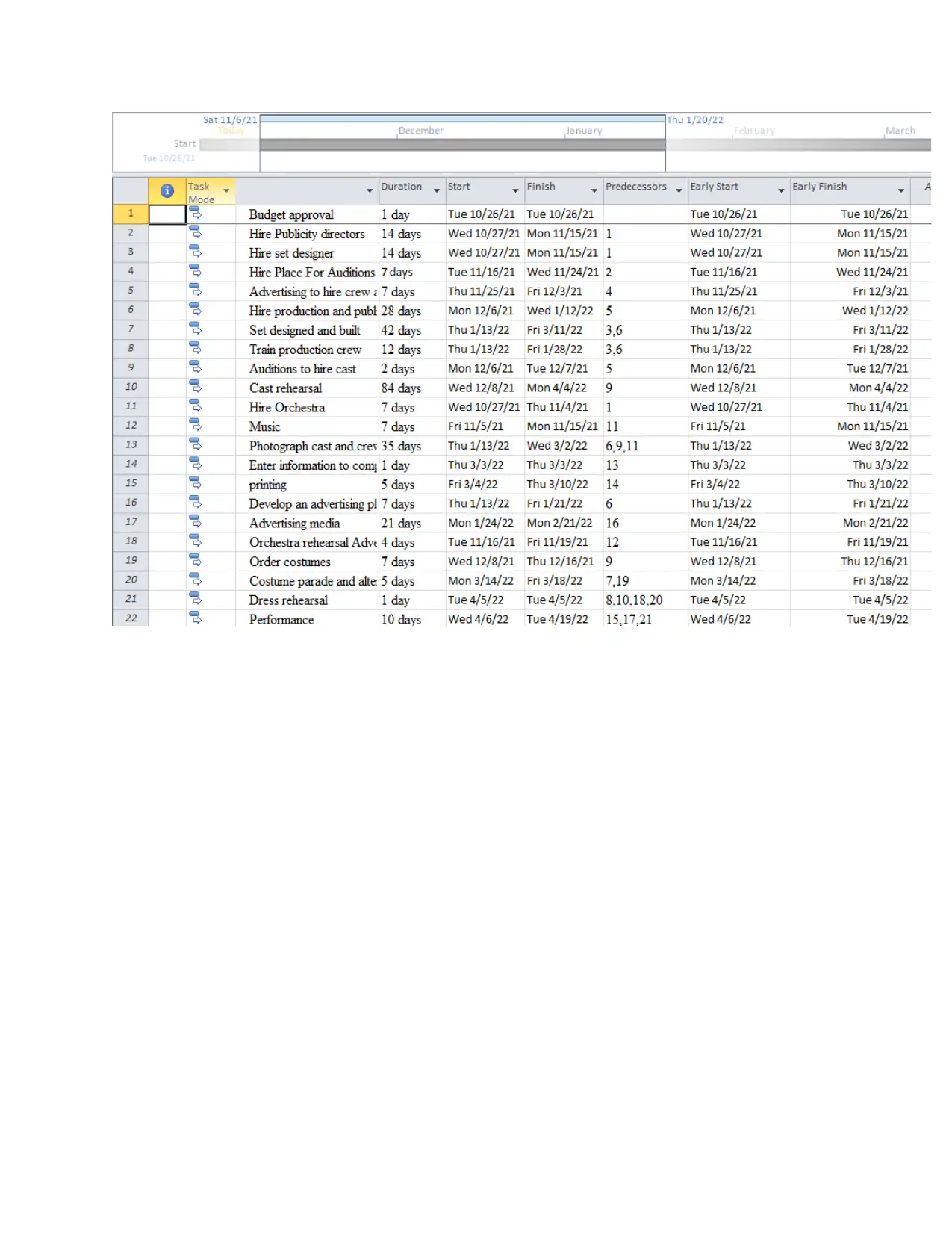
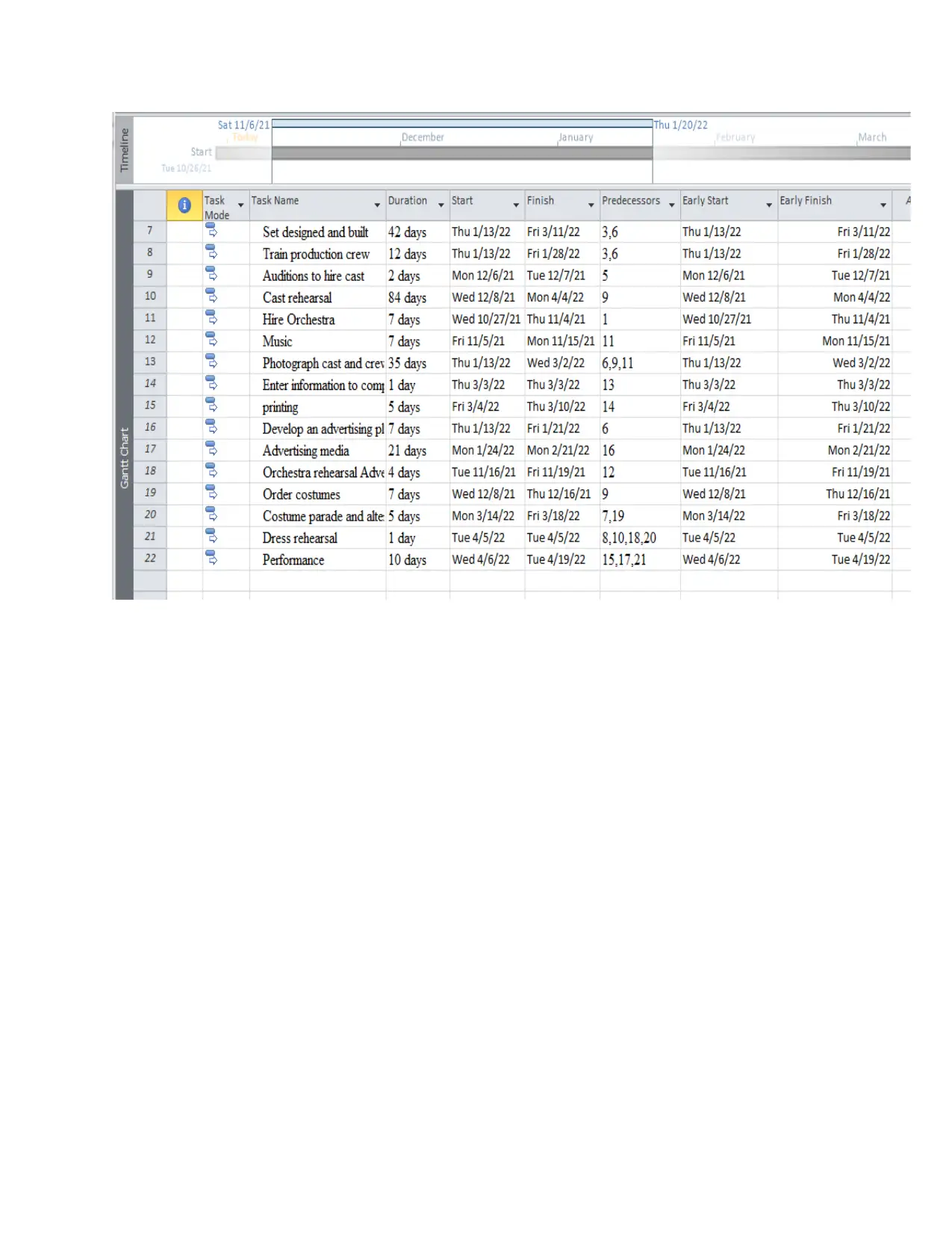
⊘ This is a preview!⊘
Do you want full access?
Subscribe today to unlock all pages.

Trusted by 1+ million students worldwide
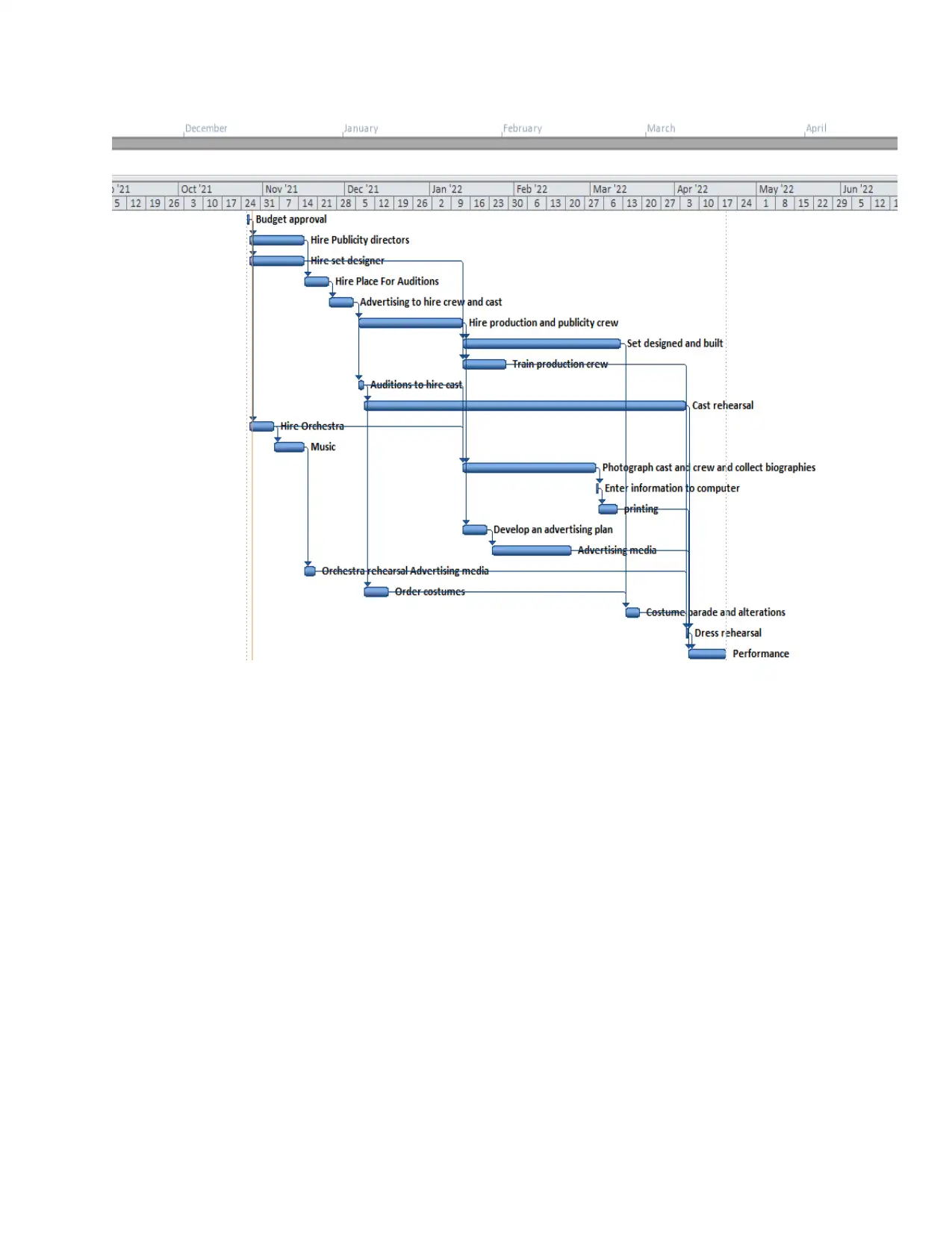
Paraphrase This Document
Need a fresh take? Get an instant paraphrase of this document with our AI Paraphraser
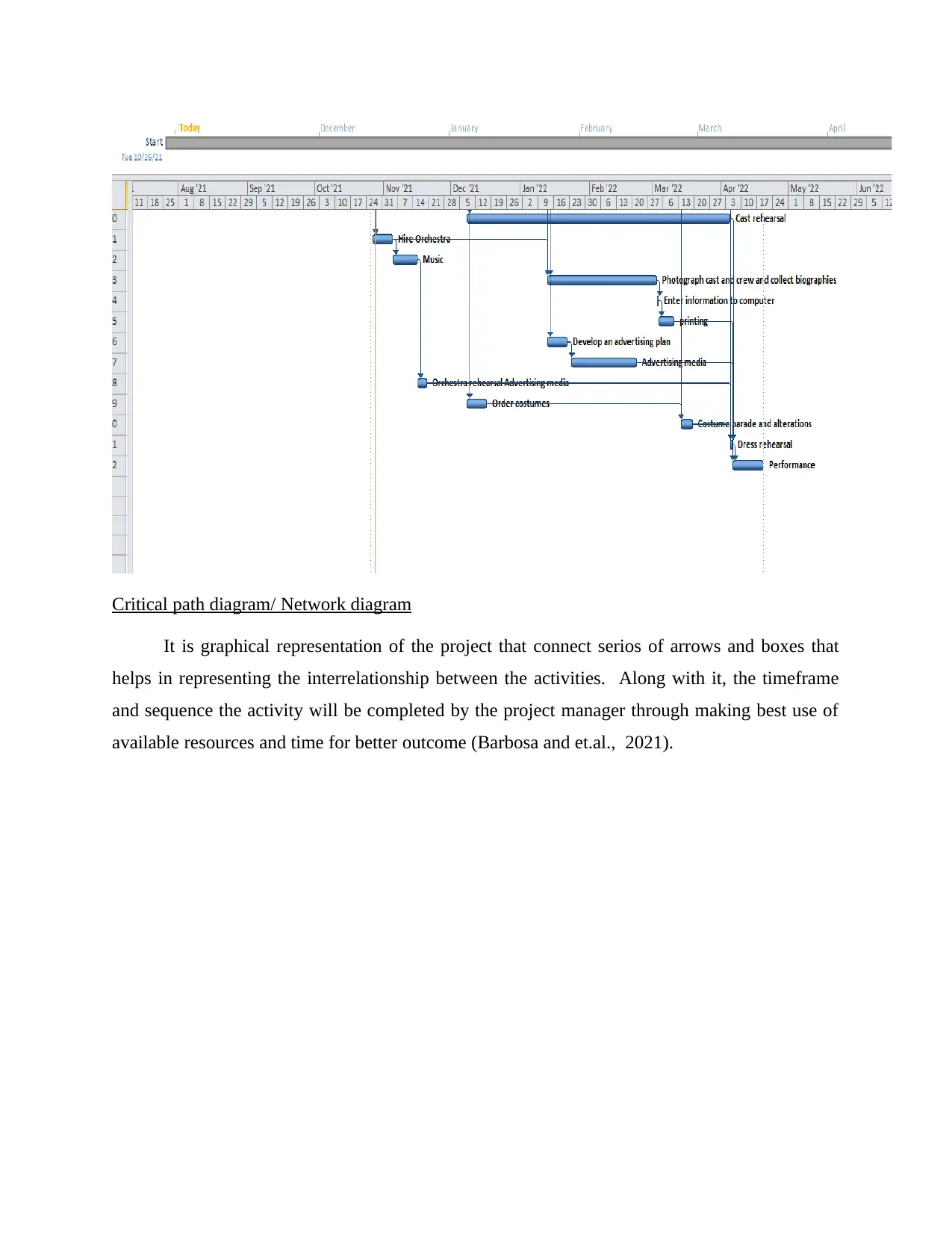
Critical path diagram/ Network diagram
It is graphical representation of the project that connect serios of arrows and boxes that
helps in representing the interrelationship between the activities. Along with it, the timeframe
and sequence the activity will be completed by the project manager through making best use of
available resources and time for better outcome (Barbosa and et.al., 2021).
It is graphical representation of the project that connect serios of arrows and boxes that
helps in representing the interrelationship between the activities. Along with it, the timeframe
and sequence the activity will be completed by the project manager through making best use of
available resources and time for better outcome (Barbosa and et.al., 2021).
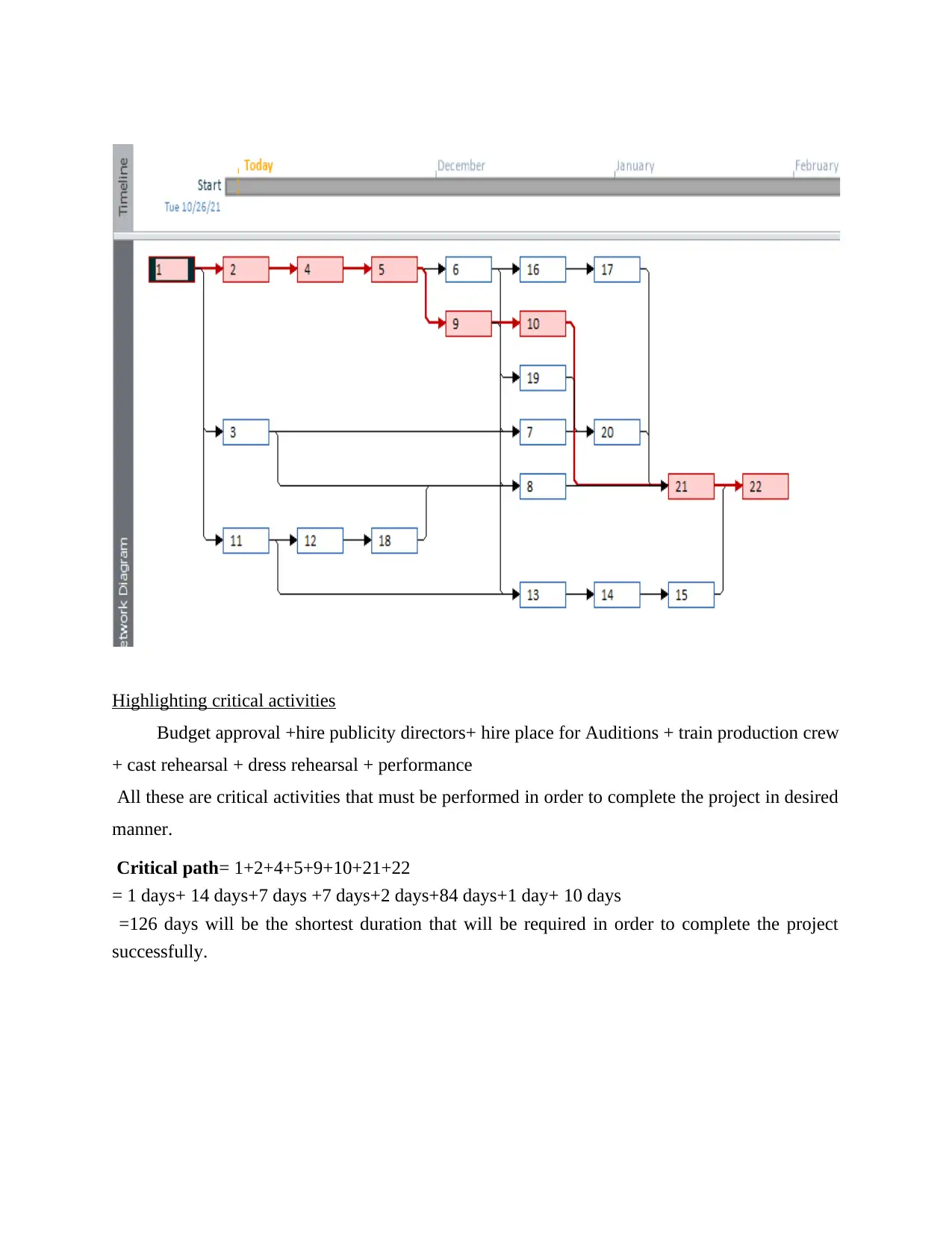
Highlighting critical activities
Budget approval +hire publicity directors+ hire place for Auditions + train production crew
+ cast rehearsal + dress rehearsal + performance
All these are critical activities that must be performed in order to complete the project in desired
manner.
Critical path= 1+2+4+5+9+10+21+22
= 1 days+ 14 days+7 days +7 days+2 days+84 days+1 day+ 10 days
=126 days will be the shortest duration that will be required in order to complete the project
successfully.
Budget approval +hire publicity directors+ hire place for Auditions + train production crew
+ cast rehearsal + dress rehearsal + performance
All these are critical activities that must be performed in order to complete the project in desired
manner.
Critical path= 1+2+4+5+9+10+21+22
= 1 days+ 14 days+7 days +7 days+2 days+84 days+1 day+ 10 days
=126 days will be the shortest duration that will be required in order to complete the project
successfully.
⊘ This is a preview!⊘
Do you want full access?
Subscribe today to unlock all pages.

Trusted by 1+ million students worldwide
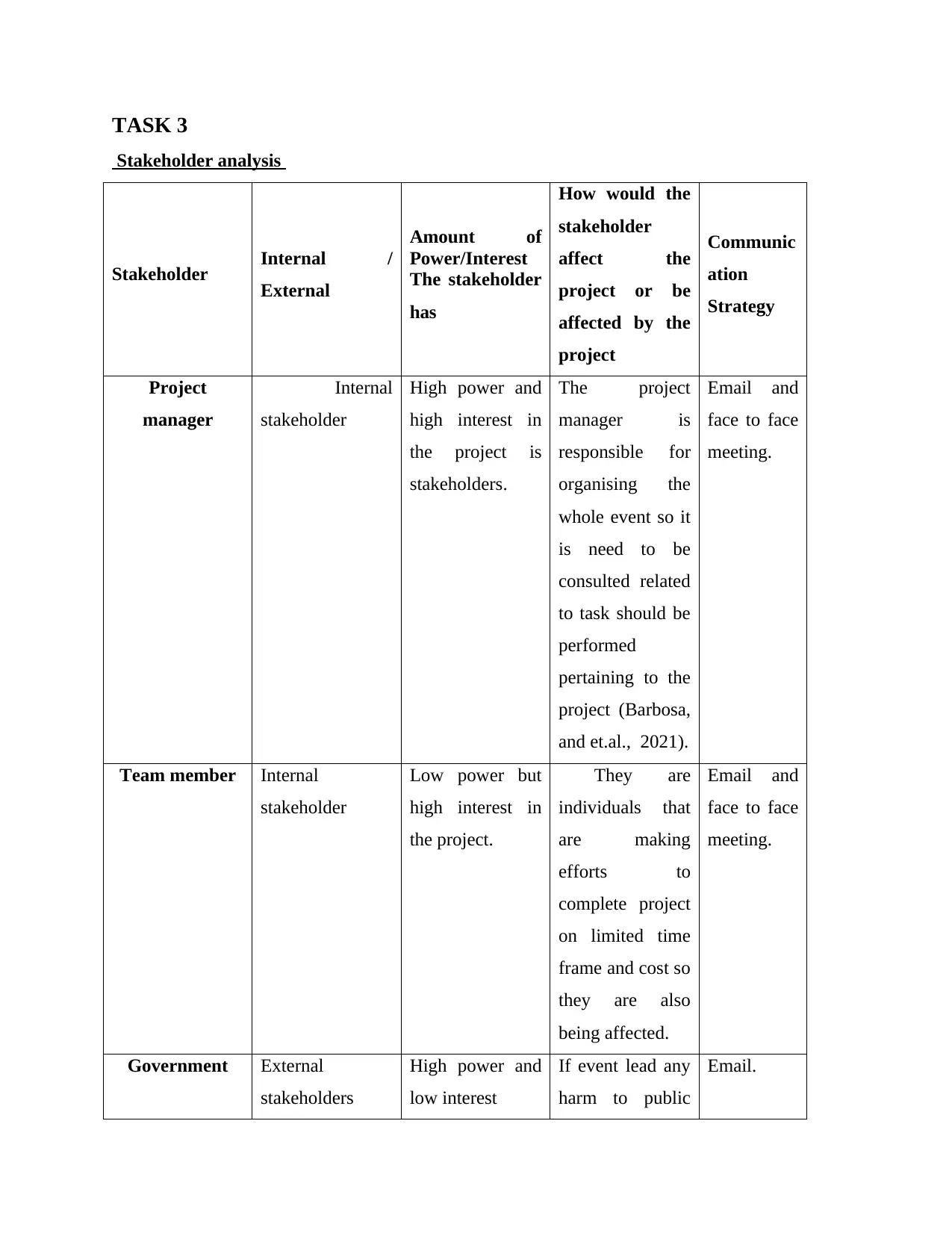
TASK 3
Stakeholder analysis
Stakeholder Internal /
External
Amount of
Power/Interest
The stakeholder
has
How would the
stakeholder
affect the
project or be
affected by the
project
Communic
ation
Strategy
Project
manager
Internal
stakeholder
High power and
high interest in
the project is
stakeholders.
The project
manager is
responsible for
organising the
whole event so it
is need to be
consulted related
to task should be
performed
pertaining to the
project (Barbosa,
and et.al., 2021).
Email and
face to face
meeting.
Team member Internal
stakeholder
Low power but
high interest in
the project.
They are
individuals that
are making
efforts to
complete project
on limited time
frame and cost so
they are also
being affected.
Email and
face to face
meeting.
Government External
stakeholders
High power and
low interest
If event lead any
harm to public
Email.
Stakeholder analysis
Stakeholder Internal /
External
Amount of
Power/Interest
The stakeholder
has
How would the
stakeholder
affect the
project or be
affected by the
project
Communic
ation
Strategy
Project
manager
Internal
stakeholder
High power and
high interest in
the project is
stakeholders.
The project
manager is
responsible for
organising the
whole event so it
is need to be
consulted related
to task should be
performed
pertaining to the
project (Barbosa,
and et.al., 2021).
Email and
face to face
meeting.
Team member Internal
stakeholder
Low power but
high interest in
the project.
They are
individuals that
are making
efforts to
complete project
on limited time
frame and cost so
they are also
being affected.
Email and
face to face
meeting.
Government External
stakeholders
High power and
low interest
If event lead any
harm to public
Email.
Paraphrase This Document
Need a fresh take? Get an instant paraphrase of this document with our AI Paraphraser
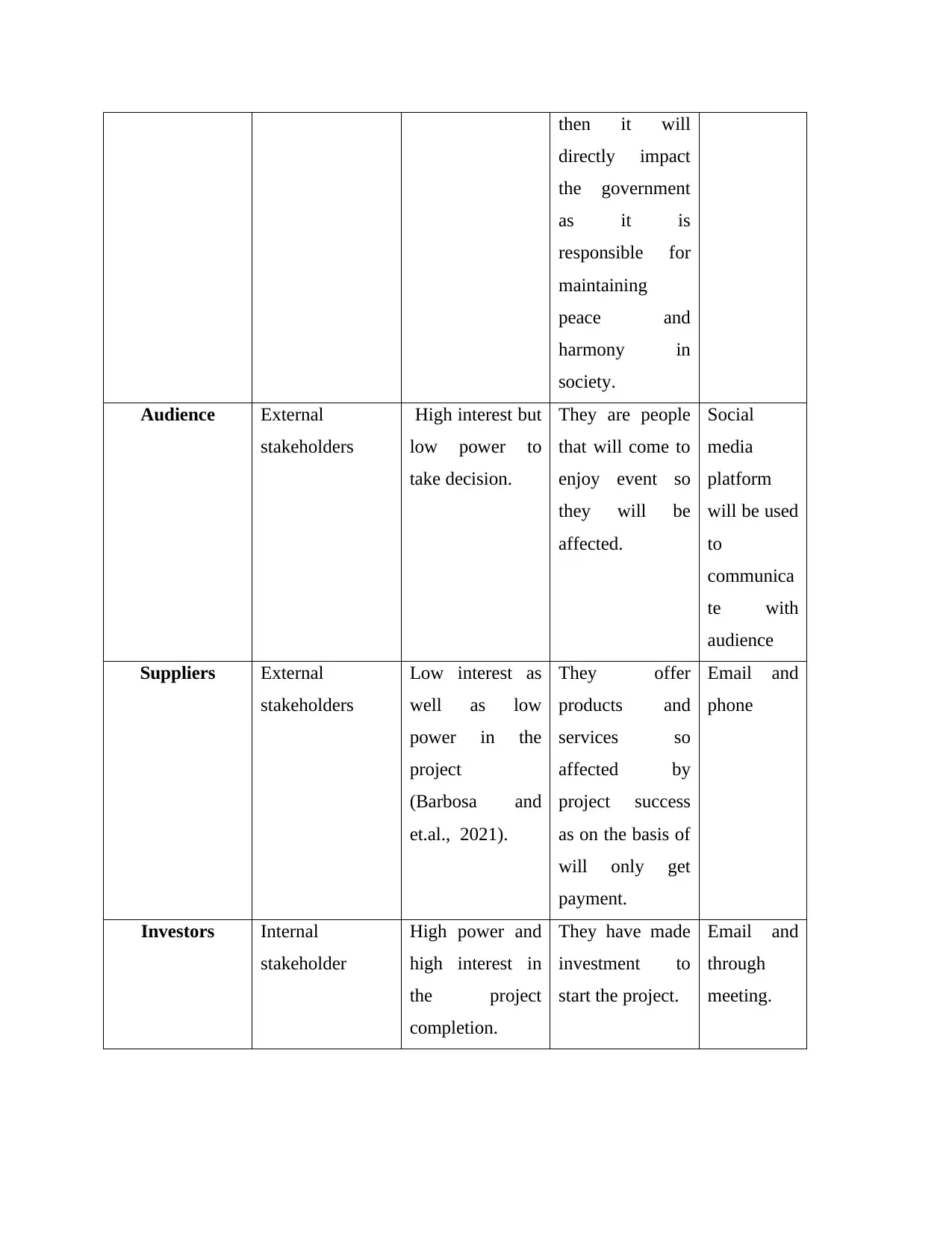
then it will
directly impact
the government
as it is
responsible for
maintaining
peace and
harmony in
society.
Audience External
stakeholders
High interest but
low power to
take decision.
They are people
that will come to
enjoy event so
they will be
affected.
Social
media
platform
will be used
to
communica
te with
audience
Suppliers External
stakeholders
Low interest as
well as low
power in the
project
(Barbosa and
et.al., 2021).
They offer
products and
services so
affected by
project success
as on the basis of
will only get
payment.
Email and
phone
Investors Internal
stakeholder
High power and
high interest in
the project
completion.
They have made
investment to
start the project.
Email and
through
meeting.
directly impact
the government
as it is
responsible for
maintaining
peace and
harmony in
society.
Audience External
stakeholders
High interest but
low power to
take decision.
They are people
that will come to
enjoy event so
they will be
affected.
Social
media
platform
will be used
to
communica
te with
audience
Suppliers External
stakeholders
Low interest as
well as low
power in the
project
(Barbosa and
et.al., 2021).
They offer
products and
services so
affected by
project success
as on the basis of
will only get
payment.
Email and
phone
Investors Internal
stakeholder
High power and
high interest in
the project
completion.
They have made
investment to
start the project.
Email and
through
meeting.
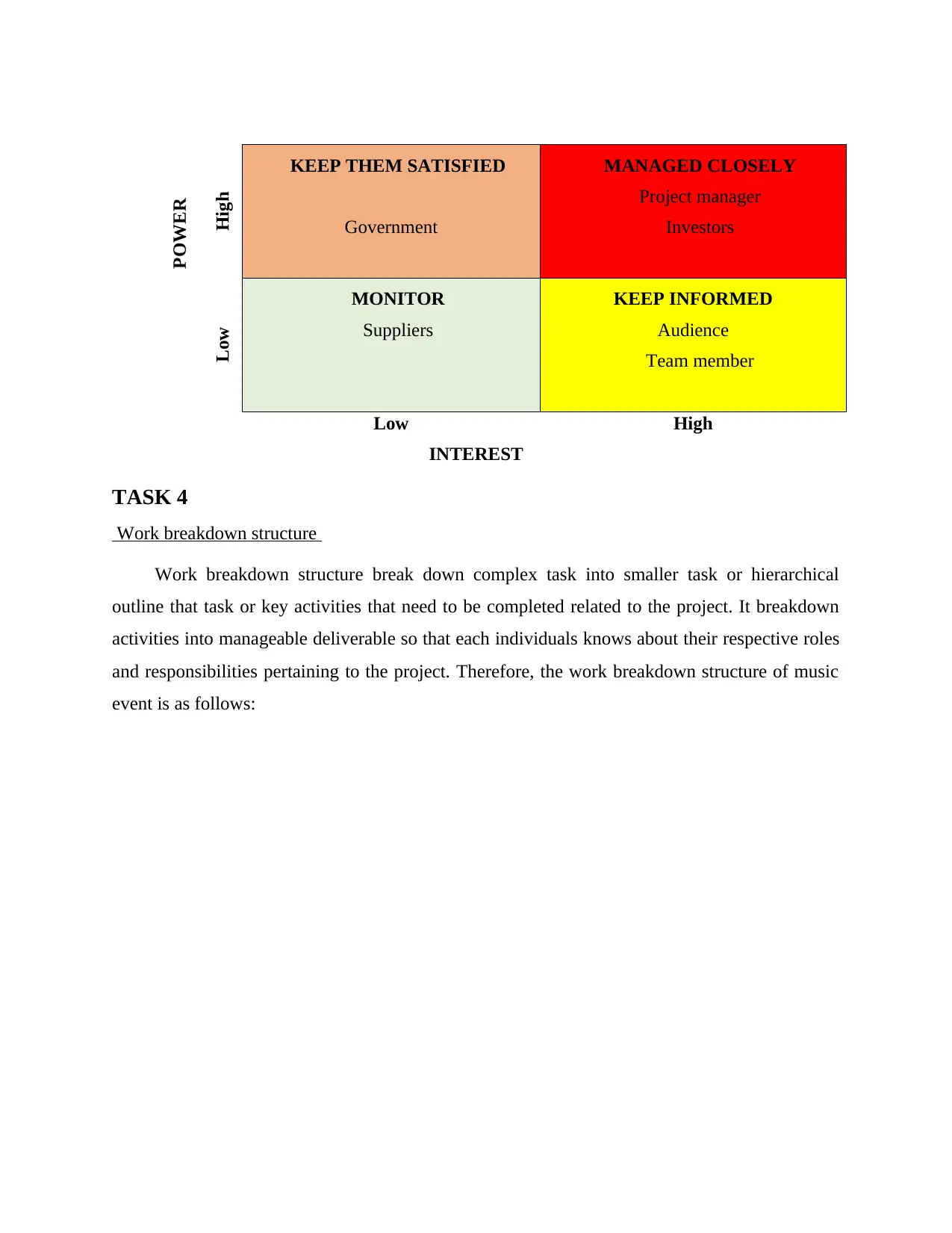
POWER
High
KEEP THEM SATISFIED
Government
MANAGED CLOSELY
Project manager
Investors
Low
MONITOR
Suppliers
KEEP INFORMED
Audience
Team member
Low High
INTEREST
TASK 4
Work breakdown structure
Work breakdown structure break down complex task into smaller task or hierarchical
outline that task or key activities that need to be completed related to the project. It breakdown
activities into manageable deliverable so that each individuals knows about their respective roles
and responsibilities pertaining to the project. Therefore, the work breakdown structure of music
event is as follows:
High
KEEP THEM SATISFIED
Government
MANAGED CLOSELY
Project manager
Investors
Low
MONITOR
Suppliers
KEEP INFORMED
Audience
Team member
Low High
INTEREST
TASK 4
Work breakdown structure
Work breakdown structure break down complex task into smaller task or hierarchical
outline that task or key activities that need to be completed related to the project. It breakdown
activities into manageable deliverable so that each individuals knows about their respective roles
and responsibilities pertaining to the project. Therefore, the work breakdown structure of music
event is as follows:
⊘ This is a preview!⊘
Do you want full access?
Subscribe today to unlock all pages.

Trusted by 1+ million students worldwide
1 out of 17
Related Documents
Your All-in-One AI-Powered Toolkit for Academic Success.
+13062052269
info@desklib.com
Available 24*7 on WhatsApp / Email
![[object Object]](/_next/static/media/star-bottom.7253800d.svg)
Unlock your academic potential
Copyright © 2020–2025 A2Z Services. All Rights Reserved. Developed and managed by ZUCOL.


